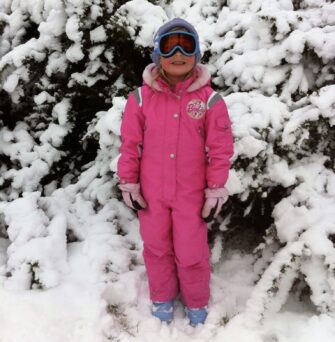Having a child who doesn’t like going to ski school can ruin your ski holiday as well as theirs. Is there anything you can do?
Of my two children, one was a ‘Ski-Do’ at ski school from day one, aged five. He went off happily every day, eventually progressing to avalanche drill and schussing the scariest of couloirs with his cool dude instructors.
Child No2, however, was a classic ‘Ski-Don’t’. Didn’t like the ski school experience, was always the one hanging off the back of the ski tiddlers-snake, terrified of getting lost on the mountain, anxiety-induced tummy aches. To her credit, she did try her best not to cry until we’d dropped her at ski school, but it was stressful for all. Even now, a keen late-teens skier, she reckons she’s got ski-school-induced PTSD: “It’s not the skiing I disliked, mum, it was the lessons.”
Parental guilt, moi? Big time.
So, is there anything you can do to help your child who doesn’t like going to ski school? Here’s what I tried and how successful it was…
1 COMFORT:
Make sure your child is comfortable in their ski kit. Clothes should be warm and easy to take on and off. Snip out any scratchy labels. Let them help choose their outfit – wanting to wear the ski suit they specially selected for ski school might act as an incentive to join in with enthusiasm.
Success rate: 3/5 (On day 1, at least. Enthusiasm subsequently plummeted)

2 A COMFORTER:
One year, my daughter spent her time on the slopes with a favourite doll tucked down her front, securely zipped inside her all-in-one. Did it help? Somewhat, although there were still PLENTY of tears. This was also the year she caught Norovirus and scarlet fever while in resort. Note to self: perhaps it’s NOT ski school that’s the problem?
Success rate: 2/5 (Slightly happier but no silver bullet. Feeling like c**p probs didn’t help)
3 SNACKS:
A little packet of sweets tucked into a safe pocket for break time is a good incentive, especially if your child isn’t normally allowed much in the way of ‘naughties’.
Success rate: 0/5 (No kidding my girl, who knew life would have been happier with us, slurping a chocolat chaud avec Chantilly in a cosy cafe)

4 ANXIETY REMEDY:
I used to send my quivering child off to ski school sucking on a ‘braveness sweetie’, with a couple more zipped into a pocket. Braveness sweeties = fruit flavoured Rescue Remedy pastilles. Did they work? Well, research suggests that Rescue Remedies can help reduce anxiety. They at least gave my little girl something to focus on mentally to help manage her worries.
Success rate: 3/5 (Recommend. Pack enough so all the kids in your group can enjoy the braveness bonus)
5 THROW MONEY AT THE PROBLEM:
The year we abandoned group lessons in favour of a private instructor was the first year EVER my daughter did not hate learning to ski. We shared the cost across two families and guess what? It was worth EVERY PENNY.
Success rate: 5/5 (Happy child = happy parent. Daughter only required private tuition for a few years before she was able to ski en famille. Bingo!)
6 DIY aka ‘DO A SALLY’:
My WhoSki co-founder Sally gave up on ski school, and she and her partner taught the kids themselves. As she puts it: “Sometimes this was bonding and at other times very, very hard work!”
Success rate: 3/ 5 on a good day (but 5/5 for affordability)
To be honest, perhaps my daughter’s aversion to group lessons stemmed from a bad experience on a dry ski slope aged four, where she got hit in the head by a rogue button lift seat. Not a great start…
Have you managed to solve the ‘Ski-Don’t’ problem? Let us know on the WhoSki social media channels.












